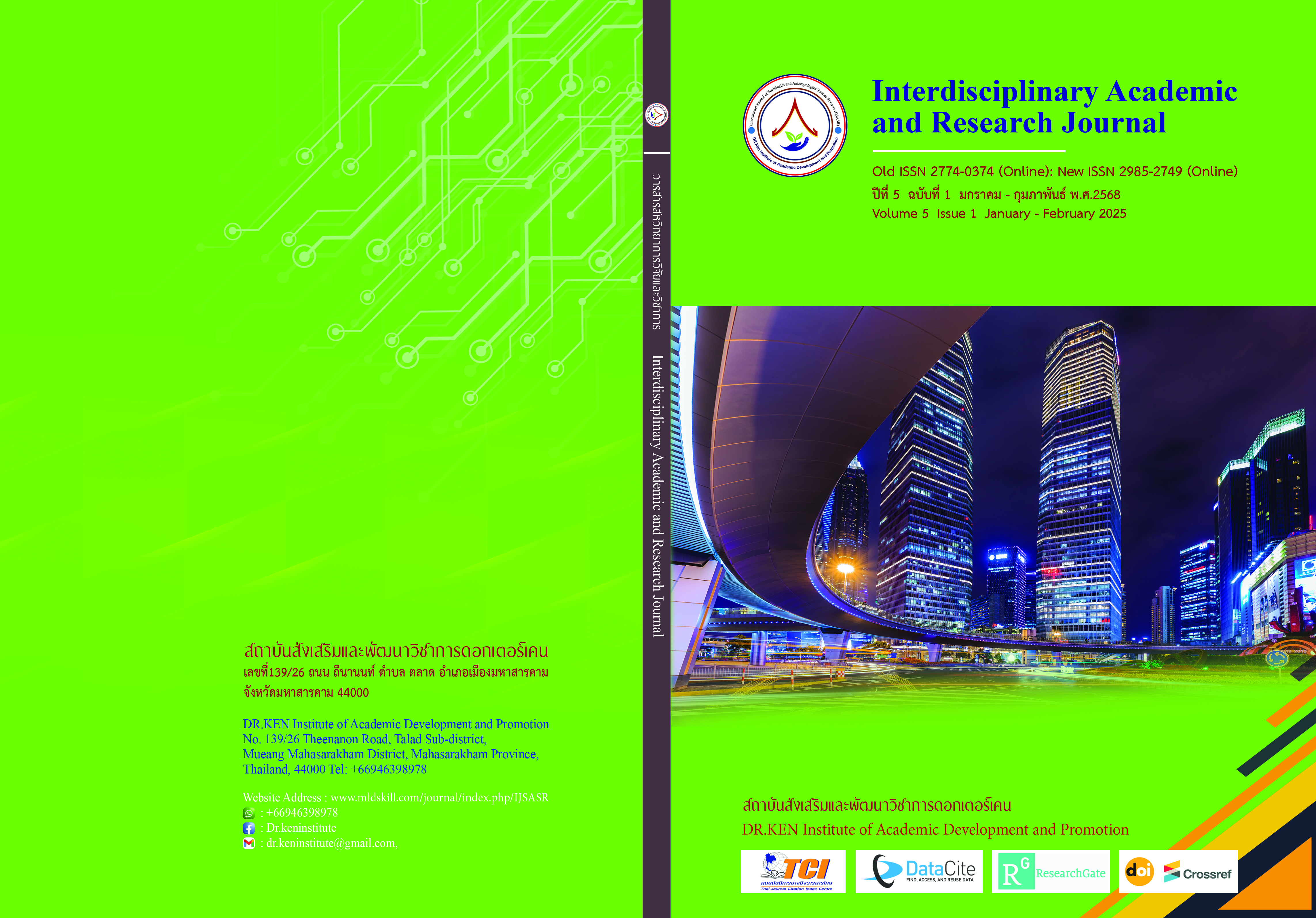Self-Confidence and Fitness Exercise of People in Bangkok
DOI:
https://doi.org/10.60027/iarj.2025.281322Keywords:
Self-confidence, Exercise, Fitness centersAbstract
Background and Aims: From the current events, people are paying more attention to exercise to have good health and to have a good personality. The purpose of this research is to study the self-confidence and exercising in fitness center of people in Bangkok Province. In order to know the behavior in exercising in fitness gyms and the self-confidence and exercising in fitness center of people in Bangkok Province. The results of the study can be used to plan strategies to attract more customers target group.
Methodology: This research is a mixed method that combines qualitative and quantitative studies. The population used in the study was people in Bangkok who exercised in fitness centers. Since the exact population size was unknown, the sample size could be calculated from W.G. Cochran's unknown sample size formula, with a 95 percent confidence level and a 5 percent error level. The sample size was at least 384. The researcher used a total sample size of 400 samples, which passed the criteria set by the conditions, which was no less than 384 samples. The tools used were questionnaires with an IOC value between 0.66-1.00. The questionnaires were also tested with 30 non-sample populations. After that, the researcher conducted all the questionnaires according to the research steps and analyzed the data from the questionnaires statistically.
Results: 1) Factors related to exercise behavior in fitness centers and self-confidence of people in Bangkok who exercise in fitness centers are not different. 2) Factors related to gender have no effect on exercise behavior in fitness centers and self-confidence of people in Bangkok who exercise in fitness centers. 3) Factors related to status, education, and income have no effect on exercise behavior in fitness centers, but have no effect on self-confidence of people in Bangkok who exercise in fitness centers at a significant difference at .05.
Conclusion: Factors related to self-confidence are related to exercise behavior of people in Bangkok who exercise in fitness centers. Understanding the relationship between exercise behavior and self-confidence is therefore important to promote exercise participation and promote positive outcomes.
References
กฤษดา ตั้งชัยศักดิ์ และ ณรัฐ วัฒนพานิช. (2563). ทัศนคติที่มีต่อการออกกำลังกายและรูปแบบการให้ บริการที่คาดหวังจากสถานออกกำลังกายของคนวัยทำงานในเขตกรุงเทพมหานคร. วารสารวิชาการ สถาบันเทคโนโลยีแห่งสุวรรณภูมิ. 6(2), 369-87.
จุฑามาศ ภิญโญศรี. (2563). มาสร้างความมั่นใจกับเทคนิคทางจิตวิทยา. Retrieved on 20 August 2022 from: https://www.msu.ac.th/msumagaz/smain/readpost.php ?mid=133.
ชยานนท์ อวิคุณประเสริฐ, ปนัสดา อวิคุณประเสริฐ, วณิชยา พันธ์จูม, นฤมล สมจี, กมลรักษ์ คนไว และปวีณา บุทธิจักร์. (2564). การศึกษาทัศนคติของนักศึกษาในการออกกําลังกายและความวิตกกังวลเกี่ยวกับรูปร่างในช่วงการแพร่ระบาดของไวรัสโควิด-19 ในเขตภาคตะวันออกเฉียงเหนือตอนบน. วารสารศิลปศาสตร์และวิทยาการจัดการ. 8 (2), 101-113.
ดาวชมพู นาคะวิโร. (2561). มารยาททางสังคมบกพร่อง อาการคนเมืองใหญ่ที่กำลังแพร่หลายในสังคม. ออนไลน์. Retrieved on 20 August 2022. https://www.rama.mahidol.ac.th/ramachannel/doctor_name/ผศ-พญ-ดาวชมพู-นาคะวิโร/
นาริน เนียมสุคนธ์สกุล (2564). ปัจจัยที่มีผลต่อพฤติกรรมการ ออกกำลังกายของประชาชนในจังหวัดนครปฐม. มหาวิทยาลัยราชภัฏนครปฐม
ปิยนันท์ สวัสดิ์ศฤงฆาร. (2560). การสร้างความเชื่อมั่นในตนเอง. Retrieved March 25, 2023 from https://drpiyanan.com/2017/06/25/article1-2/
พรีโมเเคร์ เมดิคอล. (2564). เพื่อนร่วมเดินทาง เคียงข้าง สร้างสุขภาพดีไปกับคุณ. Retrieved on 20 August 2022 from https://primocare.com/.
โรงพยาบาลกรุงเทพ (2562). การออกกำลังกายเพื่อส่งเสริมสุขภาพหัวใจ. Retrieved March 25, 2023 from: https://www.phukethospital.com/th/healthy-articles/exercise-for-healthy-heart/
โรงพยาบาลศิริราช ปิยมหาราชการุณย์ (2565). หนัก นาน บ่อย หลัการออกกำลังกายเพื่อลดน้ำหนัก. Retrieved March 25, 2023 from https://www.siphhospital.com/th/news/article/share/810
วราภรณ์ คำรศ, ชนิดา มัททวางกูร และ ชัยสิทธิ์ ทันศึก. (2562). ปัจจัยที่มีผลต่อพฤติกรรมการออกกำลังกายของกลุ่มตัวอย่างในเขตภาษีเจริญ กรุงเทพมหานคร. Chula Med Bull, 1(4), 359 – 368.
ศิริวรรณ จันทนมัฎฐะ. (2564). การออกกำลังกายเพื่อสุขภาพ. Retrieved on 27 March 2023 from http://nakorns.nfe.go.th/mueang/Nongkradon/index.php/2021-02-09-08-10-40/18-2021-08-08-09-52-34.
สิทธิพงษ์ ปานนาค. (2562). กีฬากับการพัฒนาคุณธรรมและจริยธรรมสำหรับนักเรียน. วารสารร่มพฤกษ์ มหาวิทยาลัยเกริก. 37(1), 106-115.
สิรีธร เกกีงาม. (2564). ปัจจัยส่วนประสมทางการตลาดที่มีต่อการใช้บริการฟิตเนสขนาดเล็กของผู้บริโภคในเขตภาคกลางภายใต้สถานการณ์การโควิด 19. วิทยานิพนธ์บริหารธุรกิจมหาบัณฑิต, สถาบันเทคโนโลยีพระจอมเกล้าเจ้าคุณทหารลาดกระบัง.
สุลักษณา ตันติธนวัฒน์. (2560). ทัศนคติต่อรูปลักษณ์ ความเคารพต่อรูปลักษณ์ของตนเอง และความเสมอภาค ทางเพศ ที่ส่งผลต่อทัศนคติต่อการสื่อสารด้วยสิ่งดึงดูดทางเพศและการ ตัดสินใจซื้อเครื่องสำอางของผู้บริโภคเพศหญิงกลุ่มมิลเลนเนียล. การค้นคว้าอิสระวิทยาศาสตรมหาบัณฑิต, มหาวิทยาลัยธรรมศาสตร์.
สุวัฒน โพธิคุณ (2562). ความมั่นใจสร้างได้. Retrieved March 25, 2023 from: https://www.dmc.tv/pages/ทันโลกทันธรรม/ความมั่นใจถือเป็นคุณสมบัติที่สำคัญของคนที่จะประสบความสำเร็จ-ซึ่งความมั่นใจนั้นเป็นส่วนผสมของความสามา.html.
อโนทัย ผลิตนนท์เกียรติ และคณะ. (2561). แบบแผนความเชื่อด้านสุขภาพที่มีความสัมพันธ์กับพฤติกรรมการดูแลสุขภาพตนเองของผู้ป่วยโรคความดันโลหิตสูง โรงพยาบาลส่งเสริมสุขภาพระดับตำบลบางสมัคร อำเภอบางปะกง จังหวัดฉะเชิงเทรา. วารสารวิชาการสมาคมสถาบันอุดมศึกษาเอกชนแห่งประเทศไทยในพระราชูปถัมภ์ สมเด็จพระเทพรัตนราชสุดาฯ สยามบรมราชกุมารี. 7(2), 43-52.
Ackerman, C.E. (2018). What Are Positive Emotions in Psychology? Retrieved from on 2, 2023, https://positivepsychology.com/positive-emotions-list-examples-definition-psychology/
Argyle, M., Martin, M., & Crossland, J. (1989). Oxford Happiness Inventory (OHI) [Database record]. APA PsycTests. https://doi.org/10.1037/t14420-000
Beenackers, M. A., Kamphuis, C. B., Mackenbach, J. P., Burdorf, A., & van Lenthe, F. J. (2013). Why some walk and others don't: exploring interactions of perceived safety and social neighborhood factors with psychosocial cognitions. Health education research, 28(2), 220-233.
Cochran, W.G. (1953). Sampling Techniques. New York: John Wiley & Sons.
Greenacre, L., Tung, N.M., & Chapman, T. (2014). Self Confidence and the Ability to Influence. Academy of Marketing Studies Journal, 18(2), 169-18.
Grubben, G.J.H., & Denton, O.A. (2004). Plant Resources of Tropical Africa 2. Vegetables. PROTA Foundation, Wageningen, Netherlands.
Hausenblas, H.A., & Fallon, E.A. (2006). Exercise and body image: A meta-analysis. Psychology and health, 21(1), 33-47.
Kanza, D. (2016). The importance of self-confidence in enhancing students’ speaking skills. Mohammed Kheider University of Biskra, Biskra.
Khair, K., Steadman, L., Chaplin, S., Holland, M., Jenner, K., & Fletcher, S. (2020). Parental perspectives on gene therapy for children with haemophilia: The Exigency study. Haemophilia. 27(1), 120-128. doi: 10.1111/hae.14188.
Likert, R. (1967). “The Method of Constructing and Attitude Scale,” in Attitude Theory and Measurement. P.90-95. New York: Wiley & Son.
Lilyquist, K.A. (2005). A Measure of Exercise Motivation: Variation Among Individuals Who Differ in Exercise Regularity. Dissertation Ph.D. Cappella University. Retrieved February 2, 2023, from http://wwwlib.umi.com/dissertation/fullcit
Owen, R.G. (2001). Organizational behavior in education: Instructional leadership and school - reform. Boston: Ally and Bacon.
Pampel, F.C., Krueger, P.M., & Denney, J.T. (2010). Socioeconomic Disparities in Health Behaviors. Annual review of sociology, 36, 349-370.
Perkins, K. (2018). The Integrated Model of Self-Confidence: Defining and Operationalizing Self-Confidence in Organizational Settings. Doctorate of Philosophy in Industrial/ Organizational Psychology. Florida Institute of Technology.
WHO (1999). Guidelines for Community Noise. World Health Organization, Geneva.
Woodgate, J., & Conquer, A. (2008). Exercise and self-esteem: The relationship between self-efficacy and perceived exertion. Canadian Journal of Behavioural Science, 40(3), 214-217.
Zade, T., Mahmoodi, M., & Hashemi, L. (2015). STUDY OF THE EFFECTIVENESS OF EXERCISE ON THE SELF-ESTEEM, HAPPINESS, and QUALITY OF LIFE OF YOUNG. Trends in Life Science.
Downloads
Published
How to Cite
Issue
Section
License
Copyright (c) 2025 Interdisciplinary Academic and Research Journal

This work is licensed under a Creative Commons Attribution-NonCommercial-NoDerivatives 4.0 International License.
Copyright on any article in the Interdisciplinary Academic and Research Journal is retained by the author(s) under the under the Creative Commons Attribution-NonCommercial-NoDerivatives 4.0 International License. Permission to use text, content, images, etc. of publication. Any user to read, download, copy, distribute, print, search, or link to the full texts of articles, crawl them for indexing, pass them as data to software, or use them for any other lawful purpose. But do not use it for commercial use or with the intent to benefit any business.
















.png)


